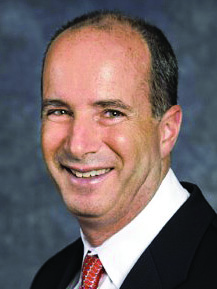The holiday season is almost upon us. Soon many of us will turn our attention to shopping lists and party planning. Lenders, however, spend the season working hard to close deals to meet annual volume targets. Economists ponder the incoming year, mulling over the possibilities of what may or may not happen.

Bank of America
Business Capital
Because each year brings revelations, we started our year-end roundtable discussion by asking about 2017’s surprises. Barry Bobrow, managing director and head of loan sales and syndication at Wells Fargo Capital Finance, was amazed that dollar volume significantly exceeded the prior year. “We had more refinancings, jumbos and M&A-related financings as well as some restructuring and DIP financings. Looking at Thomson Reuters data, the high-water mark for jumbo transactions was 2015 when there were deals valued at more than $22 billion. So far this year, we have visibility on 17, and we have a quarter to go! It was $46 billion through the first half, and the third quarter will add at least another $20 billion, putting us on track for a $90 billion to 100 billion year, well ahead of last year’s pace.”
“I had not expected our business to be so robust this year,” says Michael Sharkey, president of MB Business Capital. “I expected more of the same with limited growth in a competitive, tough environment.
Instead we closed more deals this year than we did last year, and there’s growth in our utilization rates. Our portfolio year-to-date is up 20%. In fact we just surpassed one billion dollars in loans outstanding, a nice benchmark for us, because we started this business in 2008 with no portfolio at all.”
Dave Kucera at Capital One has a different view of the marketplace. As senior managing director and head of the Financial Institutions Group, his team provides financing to non-bank lenders, including ABL lenders. “My perspective is from a capital partner/advisor to those in the ABL industry. Capital has been raised for those wanting to enter the ABL industry, but there has been less growth than we expected. ABL tends to be counter-cyclical, playing to borrowers when they have fewer financing options. Companies that can finance themselves without pledging their assets don’t lean toward ABL.”
“The institutional loan and high-yield markets have been even stronger than anticipated,” says Seth Benefield, senior vice president of Bank of America Business Capital. “Due to this strength, we experienced good deal flow as our ABL facilities pair nicely with these products. However, we have seen less revolver usage on certain new deals with companies taking advantage of favorable market conditions to upsize term loans/bonds and oftentimes leaving unfunded ABL revolvers as liquidity backstops.”
Sam Philbrick, president of U.S. Bank Asset Based Finance, was impressed by the resilience of the economy in the face of uncertainty. “Concerns about North Korea, natural disasters and the direction of national policy contribute to the level of uncertainty for businesses. Despite these factors, the economy just continues to chug along, and that bodes well for the coming year.”
“Inflation has risen a bit, and that’s a sign that businesses are doing better on the margin,” Kucera says. “However, as interest rates start to rise, it could lead to higher risk and a rising debt burden. In a market that has grown used to low rates, some companies and lenders may be less familiar with what happens when rates rise. Rising rates could put more stress on companies, so this is something we watch for.”

“Everyone’s perception seems to be that rates will not go up, and that has dampened our ability to sell interest-rate products such as swaps and caps,” Sharkey says. “I think these flat interest rates over a long period have emboldened the private equity funds, cash flow and unitranche lenders to pile enormous debt and leverage onto companies being acquired. If rates start to rise or there’s a downturn, they may not be able to bear that burden. On the other hand, it could create a wonderful ABL climate for restructuring those transactions.”
“The loans we make are on a floating rate basis, so the absolute level of rates is far less important than today’s market pricing,” Philbrick says. “The pressure on pricing over the last several years continues to deteriorate the spreads that we earn on our portfolio. While the rate of decline in pricing has slowed significantly, most of our financings involve five-year commitments; so we will be in this tight margin environment for some time.”
The continued low level of the 10-year Treasury interests Bobrow. “We’ve seen a flattening of the yield curve from three months LIBOR out to 10 years. Due to the expectation of a solid credit environment and rising rates, the institutional market has over-the-top record volume. The bond market is also quite strong, because we haven’t seen the Treasury increases that would normally cause bond investors to shy away from buying new bonds.”
“Given the low-interest-spread environment, it’s important that we grow our loan outstandings to drive profitability,” Benefield says. “To deliver for our shareholders, associates and clients, we recognize that we have to grow and win in the marketplace. However, this has to be done in the right way. We want to grow responsibly in a manner that is sustainable, within our risk framework and takes a customer-focused approach.”
Exploring Alternatives
Rather than compete against alternative lenders, many banks now realize the benefits these lenders can bring. When a piece of the financing need exceeds risk appetite, a lending partner can provide that additional layer of capital. “We frequently partner with various non-bank sources that can fill in the financing need further down the capital structure,” Philbrick says. “We have identified several providers with whom we share a like mind in terms of how we approach the client relationship. We pre-negotiate an intercredit agreement that allows us to know how the pieces of debt will fit together structurally as part of an overall solution.”
“A typical structure would be an ABL revolver coupled with a term loan B provided by an alternative lender,” Benefield adds. “Structuring intercreditor agreements in split lien transactions have become easier as market provisions are better defined. We now have experience negotiating intercreditors with many alternative lenders.”
“Our strategy has always been to leverage our relationships with key partners, some of which are SBIC funds that we invest in,” Sharkey says. “We work with them to provide a solution to unitranche and cash-flow structures. When we see problems, we solve them by bringing other instruments to the capital stack.”
“I think you see more of this activity, because there’s more capital available from different places in the market,” Kucera says. “As an ABL lender, you want to advise your customers on the best way to finance the company and help its managers evaluate different options.”
“The real story for the past few years has been the expansion of private debt where there is a bigger supply-demand imbalance than in the asset-based market, thus making it very competitive out there,” Bobrow says. “Pricing and terms have become more aggressive on the private debt, and that market may be due for a shake-out. Banks are more comfortable with their positions on leveraged lending guidance and are starting to expand their credit appetite to compete against private debt. With their cheaper cost of funds, banks can offer significant advantages to borrowers.”

Financial Institutions
Group, Capital One
“M&A has been less active in this economic cycle than previous ones,” Kucera says. “There’s been a level of uncertainty in a number of segments, and that has kept sponsors on the sidelines in some cases. The markets, management and boards tend to like certainty; they want a good idea of what the future holds for the next five-plus years. Strategic acquisitions are often not done on a levered basis, but there are still big companies using M&A to make strategic bets on expanding or getting into new businesses.”
“There is tremendous interest from the buy-out community and strategic buyers for strong companies in defensible industries,” Benefield says. “This has driven up multiples and ratcheted up expectations for all sellers coming to market. As such, buy-out sponsors are often faced with valuations they are not comfortable with or sellers not willing to trade without some catalyst event.”
“The Bass Pro/Cabelas deal is a good example of two companies combining to leverage each other’s strengths,” Bobrow says. “It’s accretive to the asset-based industry, because Bass Pro was an existing ABL borrower that is getting larger, and Cabelas is new to ABL. It adds to the outstandings, and because it’s in the retail space, it’s a sector that ABL lenders are very familiar with.”
“Even though the private equity firms say they prefer cash-flow or unitranche structures, eventually they come up with a deal that is a better fit for the ABL model,” Sharkey says. “We helped rescue a copper tube mill in Oklahoma when its much larger parent made plans to shut it down. We teamed up with management, local business leaders and government agencies to engineer a change-of-control deal that kept the plant open and saved 500 jobs.”
“In today’s marketplace, M&A activity is a double-edged sword,” Philbrick says. “We had a recent opportunity where an existing customer of our corporate bank made an acquisition and planned to migrate to an asset-based loan. In this instance M&A generated an opportunity for us. At about the same time, a long-term customer told us they were bought by a foreign company and will be financed on a cash-flow basis, so that business is leaving us.”
The Heat of Competition
The internet has changed the way customers shop, and the “Amazon effect” continues to put pressure on brick-and-mortar retailers. How are these changes affecting ABL markets and borrowers?
“Industries are constantly evolving,” Kucera says. “We look at market trends broadly as they relate to our clients and think about the impact of those trends from a risk-and-return perspective. From an ABL perspective, the challenge is to think about the risk in an overall industry as well as what’s happening in various subcategories.”
“You have to remember that retail lending has always been done with an eye toward liquidation and store or chain closures,” Sharkey says. “For years no one would lend to retailers. Then Ward Mooney, founder of Gordon Brothers Finance Company, figured out how to adapt the asset-based product to retail, and we’ve been doing it ever since. It’s proven to be a safe area for lending through the ABL product.”
“A larger portion of our clients’ revenues are now generated from fewer total customers, and we expect this trend to continue,” Benefield says. “As lenders we need to understand the potential concentration risks associated with this trend and the stickiness of the relationships between borrowers and their customers. The greater the concentration risk, the more diligence [is] required to understand those relationships. Notwithstanding, this dynamic environment creates an opportunity for us to help both existing and new clients.”

U.S. Bank Asset Based
Finance
“The Staples acquisition is interesting, because the sponsor is splitting the company into three pieces, effectively breaking the U.S. and Canadian retailers away from the B2B business,” Bobrow says. “Plenty of retailers have been able to grow their online e-tailing business. Some, like Staples, have grown it to the point where it’s a stand-alone business. Consumer-product companies are developing strategies to address the online threat. Some are figuring out how to work with Amazon, and some are figuring out how to work against them. That’s where the industry is right now, and you can’t ignore it.”
“The fact that we are the right capital solution for retailers is proving out in spades right now,” Philbrick says. “Because ABL lenders are focused on collateral values and borrower liquidity, retailers get an incredibly consistent and predictable source of financing. That’s why ABL has typically been the senior debt product of choice for the retail industry whenever leverage is involved. We give them consistent borrower debt capacity and the financial flexibility to execute their business plans in a challenging environment. This is what the ABL product is supposed to do. The ABL product also works for us as a lender. Our structure and collateral have protected us on the downside through several situations this year where the borrower ceased operations and liquidated the business.”
New Opportunities
Always on the lookout for new opportunities, we wondered what’s down the line for our ABL lenders in terms of emerging market segments or new directions they might take. Wells Fargo Capital Finance has already invested in several spin-off channels from ABL, including technology, healthcare and supply-chain finance. “We finance finance companies and have a strong UK presence,” Bobrow says. “The best way to grow your business is to know the strengths of your institution and use them to better connect to your customers by leveraging the other things that your bank can do for them. The days when bank asset-based lenders can act as a standalone are behind us.”
“We have opened additional offices throughout the country and formed an Edge Act Corporation to develop a direct lending capability in Canada,” Sharkey says. “We have been aggressively investing in SBIC funds that offer a mezzanine product of $5 million and under. That helps us compete on the unit transfer cash-flow deals at the lower end of the market. We have also expanded our direct sourcing and in-house call center.”
“We have invested in regions that we feel had potential for growth by hiring new business development officers,” Benefield says. “We continue to provide best-in-class products and solutions that include credit, treasury, risk management and investment banking. We have consistently maintained an industry-leading lead left ABL arranger market share, and we are focused on growing our middle market lending practice for companies seeking financing solutions of $5 million or more.”
“Several years ago, we moved from being a stand-alone business to a product group where we deliver our capabilities through the relationship teams that directly handle client relationships across our company,” Philbrick says. “This is consistent with the overall strategy of our bank where we deliver the entire capabilities of the bank with a fully integrated solution. Doing the right thing is a fundamental core value of our company, and we’re recognized for that.”
Kucera believes technology is at the core of finding new ways to bring customers to the ABL product. “Every lender is focused on finding better technological solutions, whether that involves sourcing opportunities or improving underwriting as part of portfolio management. Companies are looking at the impacts of technology and how to apply it both offensively and defensively.”
Looking Ahead
“Future activity is tied to a forecast of where you think the economy and overall market liquidity are going,” Kucera says. “In a market where there’s a lot of capital backing cash-flow lending, companies gravitate to that, because they can often get reasonably attractive terms without pledging assets. If the economy gets worse and capital tightens, asset-based lending becomes more attractive and busier.”
Based on current activity, Benefield is optimistic. “We are having a good year. We have had strong deal flow, and both revenue and loan outstandings are up year over year. Also, asset quality remains very good.”
“Earning assets have been going up, and I expect that to continue,” Bobrow says. “The market is still heavily driven by refinancing, but the facilities are getting bigger. Companies are growing their business and their borrowing base, resulting in jumbo deals that are upsizings of existing deals. They rely more on the asset-based loan as part of their capital structure. While it’s not a new borrower, it gives the entire market a chance to increase outstandings.”

MB Business Capital
“While I don’t expect the overall ABL market to grow significantly in 2018, I believe we have the opportunity to grow by taking additional market share,” Philbrick says. “The biggest challenge to revenue growth will continue to be market pricing, and any deterioration in spreads puts increased pressure on loan growth to expand overall revenues.”
“We just updated our strategic plan for the next three years, and we are planning for more growth,” Sharkey says. “It’s all about relationships — with our customers and our key partners. Our goal is to continue expanding and creating a good experience for everyone we come into contact with, because you never know who will be the source of your next deal.”
Our panelists are upbeat about 2018. Aside from an exogenous, geo-political event that would stir market volatility, they feel good. “Europe is growing, and the Fed is talking about unwinding its balance sheet, which is absolutely a sign of a strong economy,” Bobrow says. “You plan for growth in a positive environment, but you know it will be competitive, because your competitors are in strong positions. You have to be good to win deals.”
“We are forecasting continued growth in 2018 and are well-positioned to compete effectively in the ABL space,” Benefield says. “Absent an unforeseen event, we anticipate the domestic economy to continue to grow, albeit at a somewhat modest pace.”
“We are late in the economic cycle, but we don’t know if we are in the seventh inning of a nine-inning game or the seventh inning of a game that is going into extra innings,” Kucera says. “It is hard to forecast exactly when that cycle will shift. We try to stay flexible and keep our eyes and ears to the market in terms of what is changing and the ability of borrowers to pay back their asset-based loans.”
“Our biggest challenge is keeping this company staffed with qualified people as we grow,” Sharkey says. “The current workforce came up through companies with extensive training programs such as Heller, CIT or GE Capital. We don’t have those companies anymore, so it’s up to us to attract younger employees, train them and keep them interested and challenged.”
“Our focus is on execution,” Philbrick says. “At the end of the day, you win when you bring the right solution to the customer first. That solution has the customer at the center of it, and we bring all our capabilities to make them more successful. So often lenders try to fit the square peg into the round hole. Our goal is to arrive with the right solution and then execute it as well or better than anyone else in the marketplace.”
